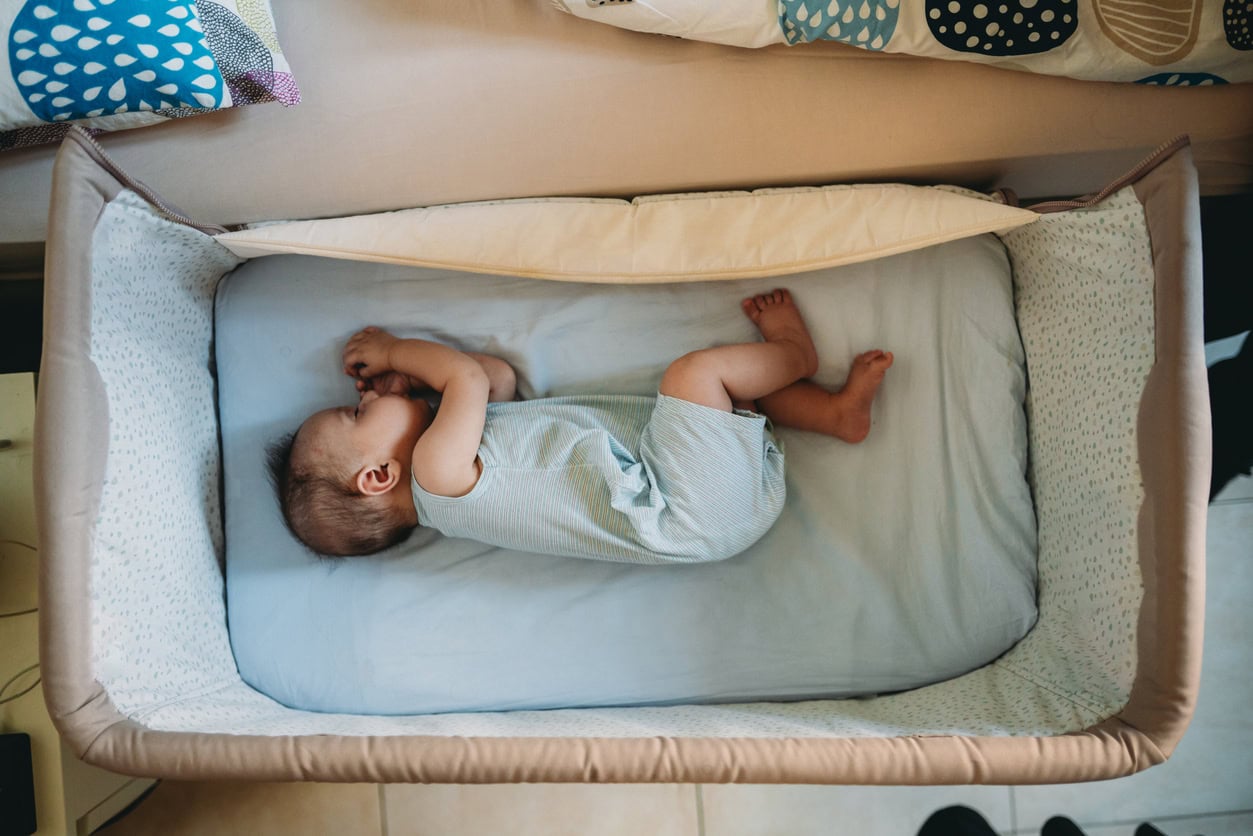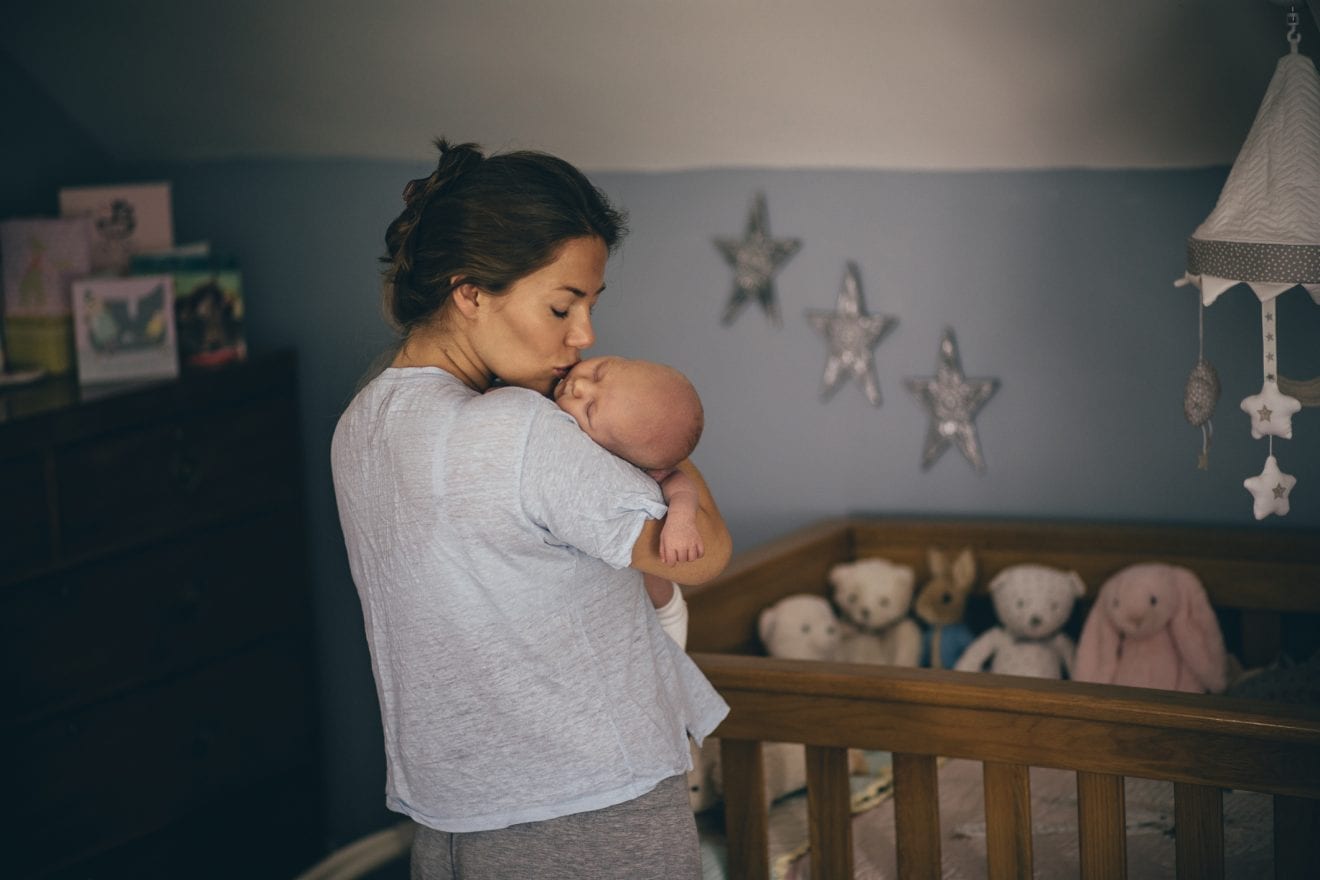Just when you think you’ve mastered getting your baby to sleep peacefully in their bassinet, it’s time to transition them to a crib. Changes in an infant’s sleep environment can often be a source of anxiety for parents. While it may seem like a daunting task, with the right approach, this transition can be a positive experience for both you and your little one. In this article, we’ll explore when to move your baby from a bassinet to a crib and share some tips on helping them make this transition.
How Long Do Babies Sleep in a Bassinet?

Babies generally sleep in their bassinet for the first 3 to 6 months of life.1 Around this time, they start to outgrow the smaller space of the bassinet and become more mobile, requiring a transition to a bigger sleeping space, such as a crib.1
You may notice that your baby is starting to roll around in the bassinet. They may also have the strength to make the bassinet move. These are telltale signs that it’s time to put the bassinet away and bring out the crib.1 However, every child is unique and develops at their own pace. It’s essential to pay attention to your baby’s individual development to know when it’s time to progress to a crib. Talk to your pediatrician if you have any questions or concerns about how long babies sleep in a bassinet and how to know when it’s time to move your baby to a crib.
When To Transition Baby to a Crib

There’s no specific age at which a baby needs to transition to a crib. But you should look out for the following developmental milestones to know when it’s time to ditch the bassinet and move your baby to the crib:1,2
- Your baby can sit up independently.
- They can push up on their hands and knees.
- They outgrow the manufacturer’s height/weight recommendations on the bassinet.
You want to provide the safest sleep environment for your baby. So, once they can sit, climb, crawl, or roll out, it’s time to transition them from the bassinet to a crib.1
How To Transition Baby to a Crib
Now that we’ve discussed sleeping in a bassinet vs. crib, let’s talk about how to get your baby to sleep in a crib successfully:
1. Have Them Practice Being in their Crib
Placing your baby in a crib and walking away can be a bit scary for them (and you) at first. You can ease the transition with baby steps until you’re both comfortable. Begin by having your baby play in the crib supervised during the day to help them get used to it. Then, start with one or two naps in the crib before moving to nighttime sleep. This allows your baby to adjust gradually without feeling overwhelmed.2
2. Recreate the Same Sleeping Environment
Babies thrive on consistency. So, creating a similar room environment will help ease the transition from the bassinet to the crib.1,2 For instance, turn off the lights if your baby is used to sleeping in a dark room. Keep any noises associated with bedtime the same as well. If you used a sound machine before, use it near the crib. In addition, keep the room temperature comfortable for your baby at about 68-72 degrees.4 Providing a safe and comfortable sleeping environment that’s similar to the bassinet will help your little one have a positive association with the crib.
3. Keep the Same Bedtime Routine
Maintaining the same bedtime routine is important when your baby is sleeping in their crib. Continuing with the same bedtime routine creates stability and signals to your baby that it’s time to sleep. This can make the transition to a crib much easier.2,5 Calming bedtime activities (such as a warm bath, bedtime story, feeding, or gentle rocking) help to establish consistency.5
4. Address Sleep Associations
If your baby has developed sleep associations with the bassinet, such as rocking or nursing to sleep, gradually transition from these habits before transitioning to the crib. Encourage self-soothing by placing your baby in the crib when they’re drowsy but not fully asleep, allowing them to learn to fall asleep independently.1,6 This may take some time for you and your baby to get used to. But you’ll thank yourself later on when your little one can drift off to sleep without constant help from you.
5. Have Patience and Be Consistent
Above all, be patient throughout the transition process.1 It’s normal for babies to protest changes initially. However, after a few days, they’ll typically adjust to their new sleep space. Consistency in your approach will make the transition from the bassinet to the crib smoother!1
Crib Sleeping Tips

As a safe sleep ambassador, I cannot stress enough the importance of safe sleep practices. The American Academy of Pediatrics (AAP) recommends that “parents sleep in the same room – but not in the same bed as a baby, preferably for at least the first six months” of life.7,8
To make sure your baby is safe in their crib and reduce the risk of sudden infant death syndrome (SIDS), follow these tips:3,8,9,10,11
- Place your baby on their back to sleep.
- Make sure the mattress is flat and not inclined.
- Ensure their sheets are fitted and tight.
- Remove any toys or objects that could pose a safety risk.
- Ensure the crib meets current safety standards.
- Don’t let your baby get overheated (they only need one more layer than you).
- Offer your baby a pacifier (but it’s okay if it falls out).
- Keep your home smoke-free.
- Check for recalls and avoid products that aren’t recommended for safe sleep.
Establishing Healthy Sleep Habits for Baby
Getting a baby to sleep in a crib is a challenge for even the most seasoned parents. Babies crave closeness and often startle as soon as you lay them down in the crib.12 While it’s tempting to snuggle your little one until they’re off in dreamland, remember to lay them down while they’re drowsy but still awake. This way, they don’t panic when they realize they’re in the crib.1,6
Transitioning your baby from a bassinet to a crib is a significant milestone. Taking gradual steps, creating a consistent sleep routine, and providing a comfortable sleep environment can help make the transition easier and set the stage for healthy sleep habits in the future. Every baby is unique and develops at their own pace, so pay attention to your little one’s cues to know when it’s time to move to the crib. Sweet dreams await once you and your baby pass this important milestone!

























